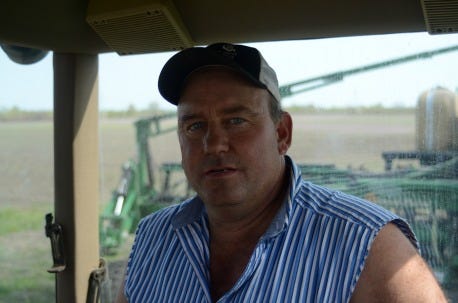
Many parts of the Midwest saw one of the wettest springs in history in 2013. From April to June, more acres than ever received 16 or more inches of rain, putting them at risk of nitrogen deficiency – an problem that has grown over the last 20 years.

NEW POSSIBILITIES: This year, Boden planted twin-row corn for the first time. Next year, he plans to apply a high-rate of nitrogen between the two rows, along with phosphorus, potash, and micronutrients in-furrow to maximize efficiency.
Henry County is no exception. Although the amount of rain the county received in 2013, 37.25 inches, isn't far above average, "About half of that rain came in three months during planting season when we try to apply our nitrogen," notes University of Missouri Extension agronomy specialist in Henry County, Travis Harper. "That's why we've been moving toward split applications. When we put out the full amount, we lose nitrogen to leaching and runoff because of the rainfall."
Optimum nitrogen utilization
It's nothing new for Wayne Boden, who has been splitting nitrogen applications on his Henry County farming operation near Truman Lake for 14 years. "Last year, we didn't have all our nitrogen down at planting like normal. We sidedressed, and you could tell visually that the sidedress really made a difference," Boden recalls. "We get wet springs and a lot of the nitrogen leaves and you see yellow corn. By that time, you've already lost yield. If you can see it, you've already lost it."
By applying a small amount early on, he doesn't lose as much nitrogen to runoff when a spring rain comes, allowing him to make the most use of available nitrogen and ensuring more goes to the corn crop.

WETTER SPRINGS: With wetter springs like last year's, applying the full amount of nitrogen early on risks losing it to runoff. Wayne Boden has been splitting nitrogen applications for 14 years.
New endeavors
This is Boden's first year applying in-furrow. His setup includes two tanks on the planter applying ten gallons per acre of 3-18-18 liquid fertilizer, along with micronutrients like copper, zinc, and manganese in-furrow. Two tanks on a front-mounted rack apply 15 gallons per acre of 29.6-0-0-3 – a high-rate of nitrogen with sulfur and nitrogen stabilizer on the surface in a concentrated stream two inches from the seed.
By applying in-furrow, Boden hopes to get the most out of phosphate, potash, and micronutrients, and provide further assurance that more is going to the crop. "It's placing it right down in the bottom of the trench, and the seed is getting placed right on top of that," he says.
This provides an opportunity to apply phosphate at a stage when the corn plant needs it most – when it determines how many rows of kernels it will have. "By applying in-furrow, you're applying them closer to the plant. It works well on ground low in phosphorus and potash," he says. "If we can get it off to a good start at the beginning it certainly makes a difference later on when we're determining yield."
Twin-row advantage
This year, Boden planted twin-row corn for the first time, allowing him to bump up his population from 24,500 to 28,500 plants per acre and still have room for his high-clearance sprayer to go through the rows.
Next year, Boden plans to apply a high-rate of nitrogen, phosphate, and potash between the two rows, along with phosphate, potash, and micronutrients in-furrow to maximize efficiency. "If I have those twin rows eight inches apart, I could put a high rate of phosphate, potash, and nitrogen about three to four inches deep," Boden says. "By placing that fertilizer deeper, I shouldn't have to worry about losing it, it will be right in the root zone."
"You've got two rows close together and you can have a row of fertilizer down the middle and both rows can utilize those nutrients," Harper explains. "We're saving ourselves a little bit by having one row of fertilizer meeting the needs of two rows in a twin row situation."
Combining twin-row with in-furrow applications, Boden looks forward to a yield increase at harvest. "If you have the plants further apart, they can enjoy more nutrients, less root crowding, and they aren't competing for the same soil," he says. "I'll have the ground canopied quicker and we'll capture more sunlight, we're hoping that translates to higher yields."
About the Author(s)
You May Also Like






